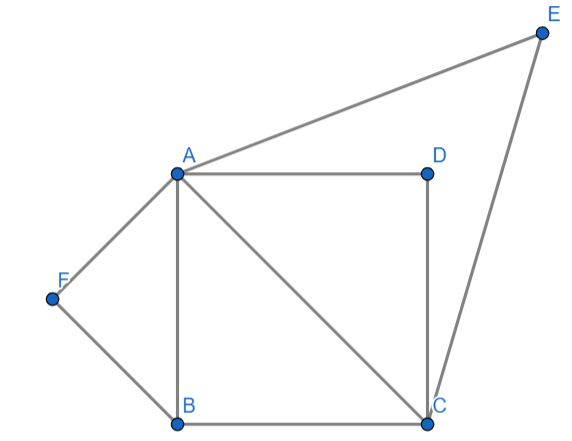
Prove that the area of an equilateral triangle described on one side of the square is equal to half the area of the equilateral triangle described on one of its diagonal.
Answer
512.5k+ views
Hint: In the above question, a triangle with all sides equal and angles equal is an equilateral triangle and two equilateral triangles are always similar. the length of side of square is a then the length of diagonal is $\sqrt{2}a.$
Complete step-by-step answer:
Let us analyze the above question through a diagram-
 .
.
Here ABCD is a square and $\vartriangle AEC$ and $\vartriangle AFB$ are two equilateral triangles described on diagonal and side of a square respectively.
We have to prove that the area of an equilateral triangle described on one side of the square is equal to half the area of the equilateral triangle described on one of it’s diagonal.
That means, $\dfrac{Area(\vartriangle AFB)}{Area(\vartriangle AEC)}=\dfrac{1}{2}$.
We know that two equilateral triangles are similar.
So, In $\vartriangle AEC$ and $\vartriangle AFB$, by SSS congruency.
$\dfrac{AE}{AF}=\dfrac{EC}{FB}=\dfrac{CA}{BA}$
We know that area of an equilateral triangle is $\dfrac{\sqrt{3}}{4}{{a}^{2}}$.
In $\vartriangle AEC$, the area of triangle can be expressed as $\dfrac{\sqrt{3}}{4}{{(AE)}^{2}},\dfrac{\sqrt{3}}{4}{{(EC)}^{2}},\dfrac{\sqrt{3}}{4}{{(CA)}^{2}}$.
and in $\vartriangle AFB$, the area of triangle can be expressed as $\dfrac{\sqrt{3}}{4}{{(BF)}^{2}},\dfrac{\sqrt{3}}{4}{{(AF)}^{2}},\dfrac{\sqrt{3}}{4}{{(AB)}^{2}}$ .
For now we will consider area of $\vartriangle AEC$ is $\dfrac{\sqrt{3}}{4}{{(AE)}^{2}}$ and the area of $\vartriangle AFB$ is $\dfrac{\sqrt{3}}{4}{{(BF)}^{2}}$.
Now, $\dfrac{Area(\vartriangle AFB)}{Area(\vartriangle AEC)}=\dfrac{\left( \dfrac{\sqrt{3}}{4}{{(AE)}^{2}} \right)}{\left( \dfrac{\sqrt{3}}{4}{{(BF)}^{2}} \right)}=\dfrac{A{{E}^{2}}}{B{{F}^{2}}}\cdot \cdot \cdot \cdot \cdot (1)$
If the length of the side of the square is ‘a’. Then by pythagoras theorem length of diagonal of square=$\sqrt{{{a}^{2}}+{{a}^{2}}}=\sqrt{2{{a}^{2}}}=\sqrt{2}a$.
The length of side AE is ‘a’ as the $\vartriangle AFB$ is described on the side of a square. So, AE=a and the length of side BF is $\sqrt{2}a$ because the $\vartriangle AEC$ is described on the diagonal of square. Now substituting AE=a and BF=$\sqrt{2}a$ in equation (1) we will get,
$\dfrac{Area(\vartriangle AFB)}{Area(\vartriangle AEC)}=\dfrac{A{{E}^{2}}}{B{{F}^{2}}}={{\left( \dfrac{AE}{BF} \right)}^{2}}={{\left( \dfrac{a}{\sqrt{2}a} \right)}^{2}}={{\left( \dfrac{1}{\sqrt{2}} \right)}^{2}}=\dfrac{1}{2}$.
So, we proved that $\dfrac{Area(\vartriangle AFB)}{Area(\vartriangle AEC)}=\dfrac{1}{2}$.
Hence, we proved that the area of an equilateral triangle described on one side of the square is equal to half the area of the equilateral triangle described on one of its diagonal.
Note: One must read the question properly and have to draw the diagram clearly and then we have to prove that the area of an equilateral triangle described on one side of the square is equal to half the area of the equilateral triangle described on one of its diagonal.
Complete step-by-step answer:
Let us analyze the above question through a diagram-

Here ABCD is a square and $\vartriangle AEC$ and $\vartriangle AFB$ are two equilateral triangles described on diagonal and side of a square respectively.
We have to prove that the area of an equilateral triangle described on one side of the square is equal to half the area of the equilateral triangle described on one of it’s diagonal.
That means, $\dfrac{Area(\vartriangle AFB)}{Area(\vartriangle AEC)}=\dfrac{1}{2}$.
We know that two equilateral triangles are similar.
So, In $\vartriangle AEC$ and $\vartriangle AFB$, by SSS congruency.
$\dfrac{AE}{AF}=\dfrac{EC}{FB}=\dfrac{CA}{BA}$
We know that area of an equilateral triangle is $\dfrac{\sqrt{3}}{4}{{a}^{2}}$.
In $\vartriangle AEC$, the area of triangle can be expressed as $\dfrac{\sqrt{3}}{4}{{(AE)}^{2}},\dfrac{\sqrt{3}}{4}{{(EC)}^{2}},\dfrac{\sqrt{3}}{4}{{(CA)}^{2}}$.
and in $\vartriangle AFB$, the area of triangle can be expressed as $\dfrac{\sqrt{3}}{4}{{(BF)}^{2}},\dfrac{\sqrt{3}}{4}{{(AF)}^{2}},\dfrac{\sqrt{3}}{4}{{(AB)}^{2}}$ .
For now we will consider area of $\vartriangle AEC$ is $\dfrac{\sqrt{3}}{4}{{(AE)}^{2}}$ and the area of $\vartriangle AFB$ is $\dfrac{\sqrt{3}}{4}{{(BF)}^{2}}$.
Now, $\dfrac{Area(\vartriangle AFB)}{Area(\vartriangle AEC)}=\dfrac{\left( \dfrac{\sqrt{3}}{4}{{(AE)}^{2}} \right)}{\left( \dfrac{\sqrt{3}}{4}{{(BF)}^{2}} \right)}=\dfrac{A{{E}^{2}}}{B{{F}^{2}}}\cdot \cdot \cdot \cdot \cdot (1)$
If the length of the side of the square is ‘a’. Then by pythagoras theorem length of diagonal of square=$\sqrt{{{a}^{2}}+{{a}^{2}}}=\sqrt{2{{a}^{2}}}=\sqrt{2}a$.
The length of side AE is ‘a’ as the $\vartriangle AFB$ is described on the side of a square. So, AE=a and the length of side BF is $\sqrt{2}a$ because the $\vartriangle AEC$ is described on the diagonal of square. Now substituting AE=a and BF=$\sqrt{2}a$ in equation (1) we will get,
$\dfrac{Area(\vartriangle AFB)}{Area(\vartriangle AEC)}=\dfrac{A{{E}^{2}}}{B{{F}^{2}}}={{\left( \dfrac{AE}{BF} \right)}^{2}}={{\left( \dfrac{a}{\sqrt{2}a} \right)}^{2}}={{\left( \dfrac{1}{\sqrt{2}} \right)}^{2}}=\dfrac{1}{2}$.
So, we proved that $\dfrac{Area(\vartriangle AFB)}{Area(\vartriangle AEC)}=\dfrac{1}{2}$.
Hence, we proved that the area of an equilateral triangle described on one side of the square is equal to half the area of the equilateral triangle described on one of its diagonal.
Note: One must read the question properly and have to draw the diagram clearly and then we have to prove that the area of an equilateral triangle described on one side of the square is equal to half the area of the equilateral triangle described on one of its diagonal.
Recently Updated Pages
Master Class 12 Economics: Engaging Questions & Answers for Success

Master Class 12 Maths: Engaging Questions & Answers for Success

Master Class 12 Biology: Engaging Questions & Answers for Success

Master Class 12 Physics: Engaging Questions & Answers for Success

Master Class 8 Maths: Engaging Questions & Answers for Success

Class 8 Question and Answer - Your Ultimate Solutions Guide

Trending doubts
Why is there a time difference of about 5 hours between class 10 social science CBSE

Write a letter to the principal requesting him to grant class 10 english CBSE

What is the median of the first 10 natural numbers class 10 maths CBSE

The Equation xxx + 2 is Satisfied when x is Equal to Class 10 Maths

Which of the following does not have a fundamental class 10 physics CBSE

State and prove converse of BPT Basic Proportionality class 10 maths CBSE




